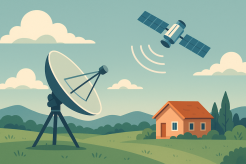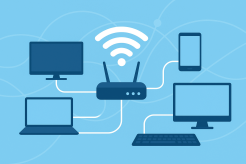How ISPs Are Evolving to Meet Rising Data Demands

Whether you're binge-watching a new series, joining a Zoom meeting, or checking smart devices around your home, you're using data—and a lot of it. With our growing digital lifestyles, Internet Service Providers (ISPs) are under pressure like never before to keep up. But how exactly are ISPs evolving to meet these rising data demands?
Let’s dig into the technological shifts, strategies, and innovations ISPs are embracing—and what it means for you.
Understanding the Surge in Data Usage
We’re living in a golden age of connectivity. Just think about the sheer volume of data needed for:
4K and 8K streaming
Massive multiplayer online games
Virtual classrooms and remote work
Smart thermostats, cameras, and assistants
All these contribute to our data footprint. And it’s only growing.
If you're curious about how different services stack up in terms of usage, check out this detailed guide on comparing data usage across popular apps and services.
What Counts as Data Usage?
Not all internet activity consumes data equally. For instance:
Streaming 1 hour of HD video = ~3 GB
Video calls for 1 hour = ~1 GB
Simple web browsing for an hour = ~150 MB
Still unsure how your daily habits add up? Learn more in this comprehensive post on what counts as data usage and how each activity contributes.
How ISPs Are Responding
To meet these rising demands, ISPs aren’t sitting still. They’re:
1. Expanding Network Infrastructure
Laying new fiber-optic cables
Upgrading backbones to reduce latency
2. Offering Higher-Speed Plans
1 Gbps plans are becoming standard in many areas
3. Rethinking Data Caps
Many ISPs now offer unlimited or flexible data plans to keep up with consumer needs
New Technologies Driving Change
Tech plays a critical role in helping ISPs stay ahead.
Edge Computing
Brings content closer to users, reducing lag and congestion.
AI and Machine Learning
Helps predict traffic surges and allocate bandwidth accordingly.
Wi-Fi 6 & 6E
Enables better performance in device-heavy households.
How Consumers Can Track Their Data Needs
If you’re not sure how much data your household uses, it’s time to get smart about monitoring. You can use this helpful mobile data usage calculator to gauge your monthly consumption.
Or go a step further and try the real-time data usage calculator to build a personalized profile of your online habits.
Addressing the Digital Divide
More than ever, ISPs are taking steps to bring internet access to underserved areas through:
Federal broadband expansion initiatives
Discounted programs for low-income households
These efforts help ensure that evolving services aren’t just for city dwellers but also for rural and suburban communities.
Personalized Plans and Tiered Services
Gone are the days of one-size-fits-all internet. ISPs now offer:
Basic browsing packages
Streamer-friendly unlimited options
Gaming-optimized plans with low latency
That means you can choose what fits you best.
Cybersecurity and Data Privacy Concerns
More data means more vulnerability. ISPs are now:
Offering built-in antivirus tools
Providing private networks and VPNs
Enhancing firewall and DDoS protection systems
These upgrades help protect your family’s online experience as data needs grow.
Regulation and Policy Changes
The way ISPs adapt is also shaped by regulations, including:
FCC mandates on speed thresholds
Ongoing debates on net neutrality
Consumer protection laws regarding throttling and privacy
These policies will continue to influence how ISPs serve their customers.
What to Expect in the Next 5 Years
Here’s where things are headed:
Even faster internet speeds with 10 Gbps trials already underway
Wider 5G coverage, especially for mobile home internet
Improved smart home integrations
AI-managed home Wi-Fi systems
The ISP world is evolving fast—and consumers will reap the benefits.
Conclusion
The bottom line? Internet Service Providers are rising to the challenge. Through infrastructure upgrades, smarter technologies, and more user-friendly plans, they’re meeting our exploding data needs head-on.
As a consumer, you can stay ahead by tracking your data usage, choosing a plan that fits your lifestyle, and being aware of the technology driving it all.
Related Posts

Fri, Dec 5, 2025 12:20 PM
TechnologyWhy You Need a VPN Today (and How It Protects You Online)
Learn how VPNs protect your data, block tracking, and secure your connection across every device.

Thu, Dec 4, 2025 3:30 AM
Internet BundlesBest Fiber Internet Providers in the US : Fast, Reliable, and Worth It
Discover the top fiber internet providers in the US, their speeds, pricing, and customer satisfaction ratings. Find the best plan for fast, reliable, and uninterrupted internet.

Thu, Dec 4, 2025 3:17 AM
Internet Bundles cheap internet dealsHughesnet Satellite Internet Review: Plans, Pricing, Speed
Get an in-depth Hughesnet Satellite Internet review covering plans, pricing, speed, and performance. Learn whether Hughesnet is the right choice for rural or remote households

Wed, Dec 3, 2025 2:36 AM
Internet BundlesBest Cheap Internet Plans Under $50 a Month You Can Actually Use
Discover the best cheap internet plans under $50 per month with reliable speeds, unlimited data, and flexible options. Compare top providers and find the right plan for your home.

Wed, Dec 3, 2025 2:05 AM
cable dealWhat Can You Really Do With a 100 Mbps Internet Connection?
Discover what a 100 Mbps internet connection can handle, from streaming and gaming to remote work. Learn how to choose the right plan for your household.